Class act: Harvard students honour architecture’s unrealised back catalogue with a pavilion for Design Miami
Watch as Unbuilt takes shape; models in Harvard GSD’s central studio space, Gund Hall, designed in 1972 by Harvard GSD alumnus John Andrews
Over the past ten years, Design Miami has established itself as December's dominant event in the global calendar. With its tropical climate and beach-backed art deco charm, the design platform has never had any problems attracting industry stalwarts to its shores, ensuring that the calibre of work on display year after year is almost always top notch.
One of the major showpieces of the fair is its architect-designed entrance, with a specially commissioned temporary pavilion installed each year. The designers to have put their definitive stamp on the pavilion in previous years include David Adjaye, Jonathan Muecke and Snarkitecture.
For the 11th edition of the fair, Design Miami has spun the commissioning process on its head. Instead of selecting one architect or practice to work with, the fair has partnered with Harvard University's Graduate School of Design (GSD) on a competition to design the pavilion; a school-wide call for entries among the student body drew 32 teams, together comprising 100 GSD students.
The winning team, made up of Joanne Cheung, Jenny Shen, Steven Meyer, Doug Harsevoort and Yiliu Shen-Burke (five first-year students from Harvard's Master in Architecture programme), proposed a grid-like canopy, decorated with models of unrealised architecture projects from within the GSD community. Named Unbuilt, the structure features 198 individually milled pink foam models that articulate the standard of work produced at Harvard GSD, while capturing the institution's spirit in one fell swoop.
'In every building that we see, there's so much behind it; most people don't understand how many ideas and concepts get created for a specific site,' explains Rodman Primack, Design Miami's executive director. 'This project to me really captures that energy and potential behind all things. There are so many ideas that don't happen from either an engineering or cost perspective. I love that this gives a window on all of that – it's the poetic side of creating architecture.'
'The idea [to partner with Design Miami] came up following some conversations with [fair founder] Craig Robins', says Mohsen Mostafavi, Harvard GSD's dean. 'We decided it would be a great thing if GSD had a real go at taking on the responsibility of organising a competition and doing the project with the students.
'One of the crucial things is that the students get exposure to what is happening in the real world. Part of the challenge was to create something that was different and to see how we could expose some of the work of the school to a broader audience.'
Since the competition was first announced in March, competing students from Harvard GSD had to assemble themselves into teams of five and work with a member of the faculty as their adviser in order to enter. The teams, spanning architecture, landscape design and urban planning, were then whittled down to five finalists in May. With no specific design brief set, the range of entries ran the gamut. There were students who wanted to deal with Miami very specifically, such as exploring its hot weather and how to create cooling on a temporary basis,' Mostafavi recalls. 'Some ideas addressed how to use ice or water to create sensory environments that would enable visitors not only to see what the space looked like, but also to feel it. There were also projects that created spaces of intimacy, and ones that were very simple and as minimal as possible.'
The final five teams had to present their concepts to an illustrious judging panel made up of both Harvard GSD faculty and Design Miami staff, an intimidating process. Primack recalls, 'To see these groups present and talk about their projects was the most fun I've had in a long time. There's a certain amount of performance that goes into presenting these projects. I'm sure it was very nerve-wracking for these student groups. But this is something they're going to continue to do in their lives, presenting projects to clients and their bosses, advocating the concepts they like to do.
'For me, it was immediately clear that [Unbuilt] was the project that I wanted to do. It spoke to me in a way that the other projects didn't about what Harvard GSD is, which is a learning institution and a place for ideas. It felt like a very generous call to the community. It was not just about bringing something evocative of someone's personal viewpoint, but something that captures the spirit of the place.'
Since winning the competition, the Unbuilt team has spent the past few months collecting project submissions from classmates and faculty alike in order to realise the project. With ideas that date back 20 years to the concepts produced by their fellow finalists in the Design Miami competition all in the mix, the team has engaged the GSD community. Working with Luis Callejas, a lecturer who taught the group in their first year, and professor in practice of architectural technology Hanif Kara, the Unbuilt team collected the concepts as digital design files and had to re-render each of them to make them suitable for casting as foam models, before milling them in a fabrication studio at the school by hand. To hit the target required for the pavilion, they've had to recruit student volunteers to help them mill a minimum of five models a week.
Despite being the youngest team that entered and having only one team member with any competition experience, the value of the opportunity was far from lost on the students. Steven Meyer says: 'The realisation that someone in the school was going to be building [the pavilion] at the end of the year was exciting and not something that comes around much.'
'From the beginning, we knew that this wasn't going to be an ordinary architecture competition,' adds Yiliu Shen-Burke. 'We had two institutions that are unique and separate entities. This pavilion had to represent the aspirations and intentions of both.'
With nearly 200 different projects taking pride of place on the canopy framework, the team also approached GSD alumni and digital-design firm Modelo to create an app to help visitors learn about each project and its creator. Serving like a digital catalogue, the collection of unrealised projects from over the years will go on to live beyond the duration of Design Miami, allowing the designs to have their day.
Summing up the venture, Mostafavi says: '[Unbuilt] is unusual because it's not so much a traditional pavilion. It's very much a concept of the future potential of things. The audience can experience it on two scales: the overall, where from a distance you don't know what it is, and then understanding that it is a kind of archive of possibilities as you get closer.'
Although Unbuilt is in essence a student-generated idea, its execution has the full power of Harvard GSD behind it. As the project inches closer towards its opening date, the baton has passed to Harvard GSD's director of exhibitions, Dan Borelli, to help the team take into consideration logistics and real-life factors, such as how the pavilion will withstand Miami's strong winds, work in accordance with the city's zoning laws and the issues surrounding installing the structure in a car park where thousands of people will be passing underneath. The steel framework has been strengthened and anchored into a cast concrete platform for added stability. Seating underneath the canopy is spread out into a more irregular format to create sociable and secluded areas. Integrated lighting in the canopy also allows the structure to be accessible even after nightfall.
Primack, meanwhile, is optimistic of more student involvement in Design Miami's future. 'There's a real impetus behind us wanting to have student talent integrated into the event, to see students excited about the fair and thinking that there's a possibility for them to move forward in that direction. The event is a platform for collectable design, the majority of which is actually a vintage market. In order to have the collectable design of the future, we need to support young designers now.'
As originally featured in the December 2015 issue of Wallpaper* (W*201)
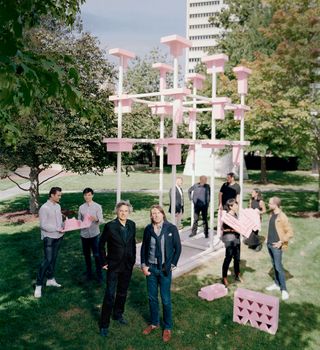
The student team that designed the pavilion, Harvard GSD staff and Design Miami's Rodman Primack stand with the engineering model at Harvard GSD's campus. Pictured front left: Mohsen Mostafavi (Dean, Harvard GSD). Right: Rodman Primack (executive director, Design Miami)
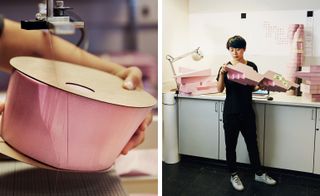
Pictured left: architectural models being hand-milled. Right: Joanne Cheung inspects a model at the team's fabrication studio space at Harvard GSD
INFORMATION
Design Miami is on view from 2 – 6 December. For more information, visit the Design Miami website
Photography: Steven Brahms
Wallpaper* Newsletter
Receive our daily digest of inspiration, escapism and design stories from around the world direct to your inbox.
Pei-Ru Keh is a former US Editor at Wallpaper*. Born and raised in Singapore, she has been a New Yorker since 2013. Pei-Ru held various titles at Wallpaper* between 2007 and 2023. She reports on design, tech, art, architecture, fashion, beauty and lifestyle happenings in the United States, both in print and digitally. Pei-Ru took a key role in championing diversity and representation within Wallpaper's content pillars, actively seeking out stories that reflect a wide range of perspectives. She lives in Brooklyn with her husband and two children, and is currently learning how to drive.
-
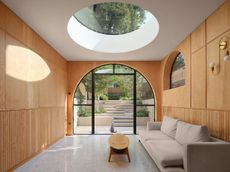 This listed house in London is transformed through a contemporary celebration of the arch
This listed house in London is transformed through a contemporary celebration of the archSegmental House, a listed house transformation by Dominic McKenzie Architects, taps into the playful powers of the contemporary arch
By Ellie Stathaki Published
-
 The Rolls-Royce Ghost Series II glides into the DMs of the world’s 1 per cent
The Rolls-Royce Ghost Series II glides into the DMs of the world’s 1 per centThe Series II version of the ‘Baby Rolls’ has slight but sophisticated revisions to keep this hefty saloon in the targets of an increasingly idiosyncratic and individualist buyer
By Jonathan Bell Published
-
 The 24 best photographs of 2024, shot for the pages of Wallpaper*
The 24 best photographs of 2024, shot for the pages of Wallpaper*Photography editor, Sophie Gladstone, completes her year in review, with some personal highlights from Wallpaper* photographers in 2024
By Sophie Gladstone Published
-
 Design Miami 2024 is alive with possibility: here are 14 things to see
Design Miami 2024 is alive with possibility: here are 14 things to seeDesign Miami 2024 opens 4-8 December – let Wallpaper* guide you to the highlights, from dazzling installations to plump sofas and anthropomorphic sculptures
By Ali Morris Published
-
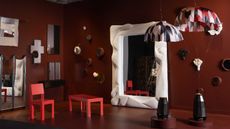 Design Miami 2022: highlights from the fair and around town
Design Miami 2022: highlights from the fair and around townDesign Miami 2022 (30 November – 4 December) aims at ‘rebooting the roots of our relationship with nature and collective structures, ecospheres, and urban contexts’
By Sujata Burman Last updated
-
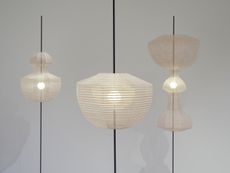 Nendo’s collaborations with Kyoto artisans go on view in New York
Nendo’s collaborations with Kyoto artisans go on view in New York‘Nendo sees Kyoto’ is on view at Friedman Benda (until 15 October 2022), showcasing the design studio's collaboration with six artisans specialised in ancient Japanese crafts
By Pei-Ru Keh Last updated
-
 Italian craftsmanship comes to Los Angeles in this eclectic Venice Canals apartment
Italian craftsmanship comes to Los Angeles in this eclectic Venice Canals apartmentBoffi Los Angeles celebrates a juxtaposition of texture throughout a waterside bolthole
By Hannah Silver Last updated
-
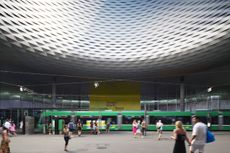 Design Miami/Basel 2022 explores the Golden Age
Design Miami/Basel 2022 explores the Golden AgeDesign Miami/Basel 2022, led by curatorial director Maria Cristina Didero, offers a positive spin after the unprecedented times of the pandemic, and looks at the history and spirit of design
By Rosa Bertoli Last updated
-
 Kvadrat’s flagship New York showrooms encompass colourful design codes
Kvadrat’s flagship New York showrooms encompass colourful design codesIndustrial designer Jonathan Olivares and architect Vincent Van Duysen have worked with Danish textile brand Kvadrat on the vast new space, also featuring furniture by Moroso
By Hannah Silver Last updated
-
 What to see at New York Design Week 2022
What to see at New York Design Week 2022Discover Wallpaper’s highlights from New York Design Week 2022 (10 – 20 May 2022): the fairs, exhibitions and design openings to discover
By Pei-Ru Keh Last updated
-
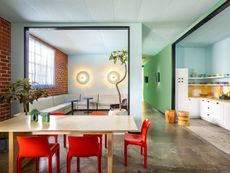 Colour defines LA ceramics studio and showroom of Bari Ziperstein
Colour defines LA ceramics studio and showroom of Bari ZipersteinStep inside the multifunctional ceramics studio, office and showroom of designer and artist Bari Ziperstein, designed by local firm Foss Hildreth
By Pei-Ru Keh Last updated